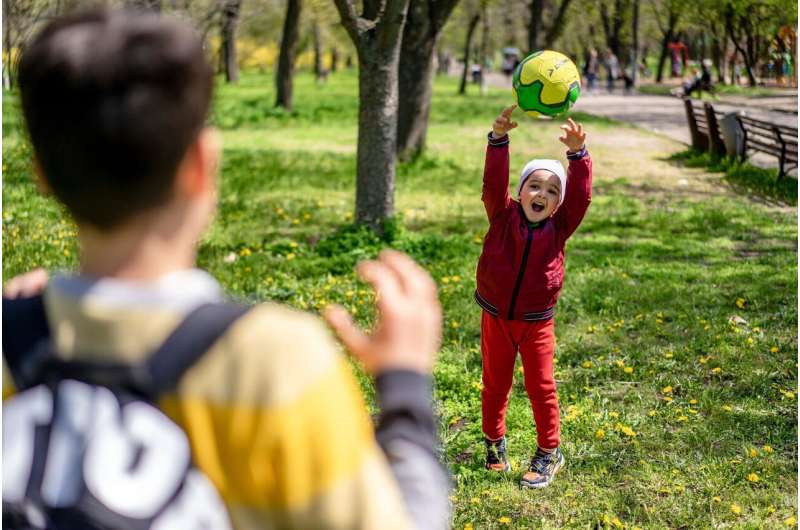This article has been reviewed according to Science X's editorial process and policies. Editors have highlighted the following attributes while ensuring the content's credibility:
fact-checked
peer-reviewed publication
trusted source
proofread
Researchers find elementary age children experience more concussions during activities unrelated to sports

Researchers from Children's Hospital of Philadelphia (CHOP) found that young children between the ages of 5 and 12 were more likely to experience a concussion from recreation and other non-sport activities, yet those injuries were not seen by specialists until days later compared with sports-related concussions in the same age group.
This study suggests concussion research is needed for children outside of sports and that providing more resources and education to those providers diagnosing most concussions in this age group, particularly emergency departments and primary care, could reduce inequities in concussion care regardless of the mechanism of injury by which these patients experience concussions. The findings were recently published by the Journal of Pediatrics.
Adolescents experience high rates of sports- and recreation-related injuries, but the rate of injuries among children ages 5 through 12 is still high, at about 72.7 injuries per 1000 children. More than half of children in this age range participate in sports, as daily physical activity is recommended for optimal health and development, but with these activities comes a risk of pediatric concussion.
Most of the research into pediatric concussions has focused on adolescents and sports, which highlights a need to study concussions in younger children across all mechanisms of injury. Prior studies from nearly a decade ago reported the importance of non-sports and recreation-related concussions in elementary age children. Injuries sustained in these settings are marked by key differences in supervision at the time of injury that can influence how quickly a concussion is recognized, affecting access to and timing of care, which can lead to longer recovery times.
"In prior research, recreation-related injuries are not often differentiated from sports-related injuries, yet this study shows that these injuries can be just as serious and occur more frequently in this age group, suggesting that education and awareness about concussion needs to be emphasized to those who interact with children in these less structured settings," said senior study author Kristy Arbogast, Ph.D., director of the Center for Injury Research and Prevention and co-director of the Minds Matter Concussion Program at CHOP.
"Patients injured outside of sports and recreation experienced a higher burden of symptoms and more changes to daily life, and delays in appropriate care could exacerbate these negative effects."
Using contemporary data from a pediatric concussion registry, researchers examined this age range and characterized concussions by their mechanisms of injury, distinguishing between injuries that occurred in organized sports and those that occurred outside of sports. They separated recreation, such as gym class, free play, or non-competitive sporting activities like biking, from other non-sports mechanisms, like motor vehicle crashes or falls, owing to the role of unstructured play in this age group.
A total of 1,141 patients between the ages of 5 and 12 with concussions were evaluated within four weeks of injury and were included in this analysis. The researchers assessed whether the injury occurred during sports, recreation, or some other mechanism of injury ("non-sports-or-recreation-related"). Variations in demographics, point of health care entry, and clinical signs were evaluated across mechanisms.
The study found that recreation-related injuries were the most common in this age group at 37.3% of injuries, followed by non-sports-or-recreation-related concussions at 31.9%. These injuries were more likely to be seen first in the emergency department compared to sports-related concussions.
Importantly, patients with recreation- or non-sports or recreation-related concussions were first evaluated by concussion specialists an average of 2 to 3 days later than sports-related concussions. Patients with concussions outside of sports and recreation also reported worse symptoms, including more visio-vestibular issues and more changes to sleep and other daily habits compared with the other patient groups.
"We see these findings as an opportunity to equip the clinical teams who may see these patients first with the latest tools for concussion diagnosis and management," said study co-author Daniel Corwin, MD, Director of Research Operations in the Division of Emergency Medicine and Emergency Department Lead of the Minds Matter Concussion Program.
"These findings could also serve as a basis for school-based resources, including engagement of school nurses, to help address disparities in care across these injuries, particularly in this less well understood elementary age population of patients who sustain their injuries outside of sports."
More information: Patricia R. Roby et al, Characteristics of Pediatric Concussion across Different Mechanisms of Injury in 5 through 12-Year-Olds, The Journal of Pediatrics (2024). DOI: 10.1016/j.jpeds.2024.114157




















